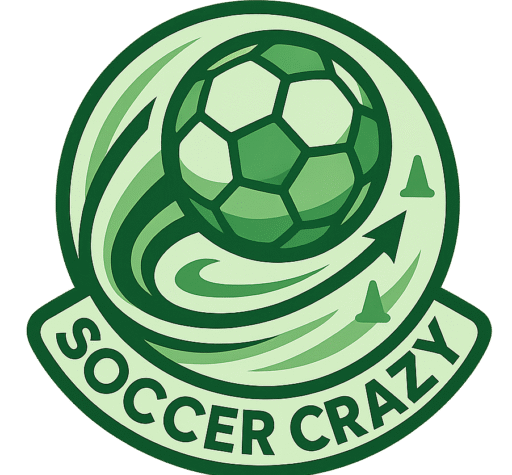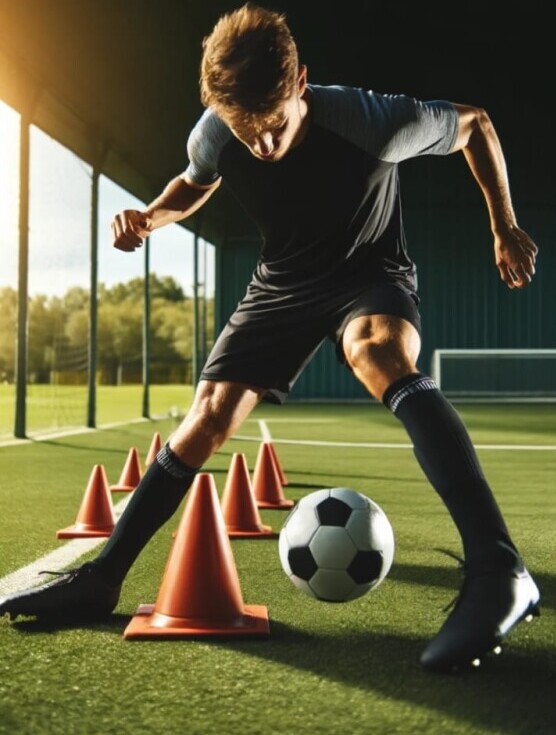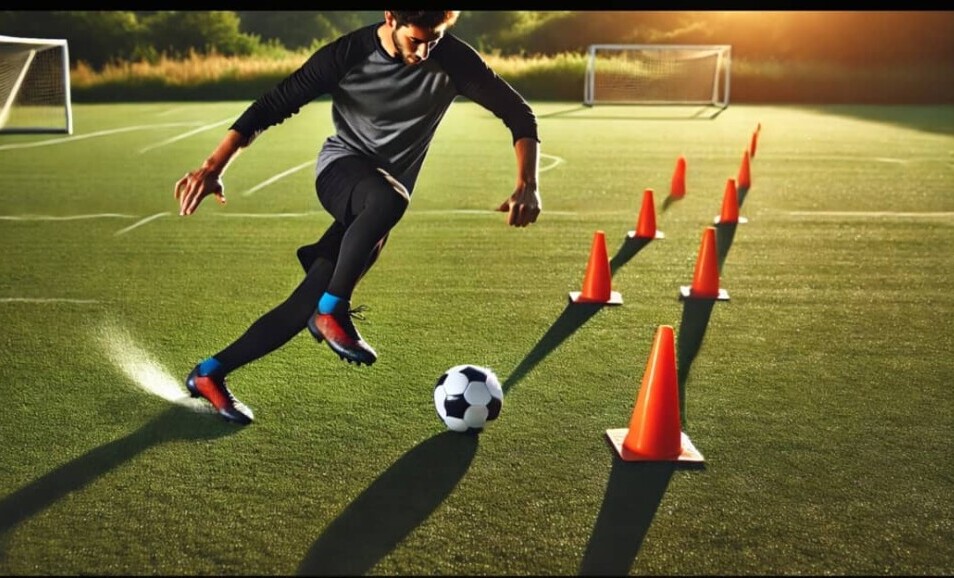Dribbling is a fundamental skill in soccer that varies greatly depending on the player’s position on the field.
Each role requires specific dribbling techniques to effectively maneuver around opponents and make the most impact.
Whether you’re a forward aiming to break through defenses or a midfielder looking to control the pace of the game, mastering the right dribbling moves for your position is crucial.
In this guide, we’ll explore essential dribbling moves tailored for different soccer positions, providing you with the skills needed to excel in your role.
i . Dribbling for Forwards
a . Quick Cuts and Accelerations
- Purpose: Forwards often need to quickly change direction and accelerate past defenders.
- Drills:
-
- Cone Weaves: Set up cones in a zigzag pattern and dribble through them, focusing on sharp cuts and rapid changes in direction.
- Acceleration Sprints: Start from a standing position and dribble at high speed towards a target, practicing explosive acceleration.
- Purpose: Forwards frequently face one-on-one situations where they need to beat a single defender.
- Drills:
-
- 1v1 Practice: Pair up with a teammate and take turns attacking and defending. Focus on using quick footwork and change of pace to get past the defender.
- Attacker vs. Defender: Set up a small grid where the attacker tries to dribble past the defender using various dribbling moves.
c . Nutmegs and Feints
Purpose: Nutmegs and feints can be effective for creating space in tight areas.
Drills: Nutmeg Drill: Practice dribbling the ball through a defender’s legs and recovering it on the other side.
Feint Practice: Use body feints and fake movements to trick defenders into committing to a direction before dribbling past them.
d. Dribbling for Midfielders
a . Shielding and Ball Control
- Purpose: Midfielders need to maintain possession and shield the ball from opponents.
- Drills:
-
- Shielding Practice: Practice using your body to shield the ball from a defender while keeping close control.
- Close Ball Control: Use small touches to keep the ball close while navigating through tight spaces.
b . Change of Pace
- Purpose: Midfielders often use changes in pace to create space and evade defenders.
- Drills:
-
- Accelerate and Decelerate: Dribble at varying speeds, practicing sudden accelerations and decelerations to simulate game situations.
- Speed Drills: Incorporate cone drills where you alternate between fast dribbling and slow, controlled dribbling.
c . Turning and Passing
- Purpose: Effective turning allows midfielders to quickly shift direction and maintain flow in the game.
- Drills:
-
- Turning Drills: Practice various turning techniques such as the Cruyff Turn or the Maradona Turn in tight spaces.
- Passing Integration: Combine dribbling with passing drills to enhance decision-making and fluidity.
iii . Dribbling for Defenders
a . Dribbling Out of Defense
- Purpose: Defenders sometimes need to carry the ball forward and participate in attacks.
- Drills:
-
- Dribbling Up the Field: Practice dribbling the ball out of the defensive third and into the midfield, focusing on control and composure.
- Pressure Drills: Simulate scenarios where defenders are under pressure and need to dribble past opponents while maintaining control.
b . Ball Protection and Control
- Purpose: Defenders must protect the ball while advancing and avoid losing possession.
- Drills:
-
- Ball Protection Drills: Work on keeping the ball close and protecting it from opposing players while moving forward.
- Controlled Dribbling: Practice dribbling with minimal touches and keeping the ball close to your body.
c . Combining Dribbling with Defensive Skills
- Purpose: Integrate dribbling with defensive maneuvers to enhance overall effectiveness.
- Drills:
-
- Dribble and Defend: Practice dribbling drills that include defensive challenges, such as dribbling while a defender tries to intercept.
- Transition Drills: Work on transitioning from defensive to attacking play through dribbling, simulating real-game scenarios.
iv . Dribbling Tips and Techniques
a . Body Position and Balance
- Tip: Maintain a low center of gravity and use your body to shield the ball. Keep your knees slightly bent and your weight balanced.
b . Using Both Feet
- Tip: Practice dribbling with both feet to improve versatility and effectiveness. Use the inside, outside, and sole of your foot to control the ball.
c . Reading the Opponent
a. Tip: Observe the opponent’s positioning and anticipate their movements. Use this information to make quick decisions and execute effective dribbling moves.
Incorporating Dribbling into Training
Dribbling under pressure is a crucial aspect of soccer that requires players to maintain control and composure while being challenged by opponents.
Practicing dribbling under pressure helps players develop the skills and confidence needed to perform in high-stakes game situations.
To practice dribbling under pressure, try the following drills:
- Pressure Dribbling Drill: Set up a series of cones or small hurdles and have a teammate or coach apply pressure while you dribble through the course.
- Game Situation Drill: Practice dribbling in game-like situations, such as 1v1 or 2v1, where you must maintain possession while being pressured by opponents.
- Small-Sided Games: Play small-sided games, such as 3v3 or 4v4, where players must dribble and make decisions quickly while under pressure.
vi. Dribbling with Vision
Maintaining good vision while dribbling is essential for soccer players. This involves keeping an eye on teammates, opponents, and the ball, allowing you to make informed decisions and execute effective dribbling moves.
To improve your vision while dribbling, try the following:
- Keep Your Head Up: Focus on keeping your head up and eyes forward, scanning the field for teammates, opponents, and open spaces.
- Use Your Peripheral Vision: Develop your peripheral vision by practicing awareness of your surroundings while dribbling.
- Practice Dribbling with Obstacles: Practice dribbling through cones or around obstacles while maintaining vision and control.
vii. Dribbling and Decision-Making
Dribbling and decision-making are closely linked in soccer.
Effective dribblers must be able to read the game, identify opportunities, and make quick decisions to exploit them.
To improve your decision-making while dribbling, try the following:
- Practice Game Situation Drills: Practice dribbling in game-like situations, such as 1v1 or 2v1, where you must make quick decisions to maintain possession or create scoring opportunities.
- Develop Your Spatial Awareness: Practice awareness of your surroundings, including the position of teammates, opponents, and open spaces.
- Analyze Game Footage: Analyze game footage to identify areas for improvement and develop strategies for making better decisions while dribbling.
viii. Dribbling Drills for Younger Players
Younger soccer players require modified drills that focus on developing fundamental dribbling skills.
Here are some drills suitable for younger players:
- Cone Weave Drill: Set up cones in a zigzag pattern and have players dribble through them, focusing on ball control and agility.
- Red Light, Green Light Drill: Divide players into pairs, with one player acting as the “stoplight” and the other player dribbling towards them. The stoplight calls out “red light” and the player must stop the ball, then “green light” and the player can continue dribbling.
- Dribbling Obstacle Course: Set up an obstacle course with cones, hurdles, or small obstacles and have players dribble through it, focusing on ball control, agility, and vision.
ix. Incorporating Dribbling into Training
a . Drills and Exercises
- Drill Integration: Incorporate position-specific dribbling drills into regular training sessions. Ensure drills simulate game situations and involve various scenarios.
b . Small-Sided Games
- Game Simulation: Use small-sided games to practice dribbling under pressure and make quick decisions. This helps players adapt dribbling skills to real-game contexts.
c. Video Analysis
- Performance Review: Record and review training sessions to analyze dribbling techniques and identify areas for improvement. Provide feedback based on video analysis.
x. Common Dribbling Mistakes
Even experienced soccer players can fall victim to common dribbling mistakes. Here are some common errors and tips on how to correct them:
- Over-Dribbling: Over-dribbling can lead to loss of possession and create scoring opportunities for opponents. To correct this, focus on making quick, decisive movements and using your vision to identify opportunities to pass or shoot.
- Losing Possession: Losing possession can be costly in soccer. To correct this, focus on maintaining good ball control, using your body to shield the ball, and being aware of your surroundings.
- Failing to Shield the Ball: Failing to shield the ball can lead to loss of possession and create scoring opportunities for opponents. To correct this, focus on using your body to protect the ball, keeping your knees bent and your weight balanced.
Conclusion
Mastering dribbling moves tailored for different positions enhances a player’s effectiveness on the field.
Forwards, midfielders, and defenders each have unique dribbling needs that contribute to their overall performance.
By incorporating specific dribbling drills, practicing position-based techniques, and continually refining skills, players can become more adept at navigating opponents and making impactful plays.
Embrace these techniques and watch as your dribbling skills elevate your game to the next level.
Lets keep the conversation going. I would really like it if you can leave your experience, suggestions and questions in the comment section below. I promise to get back to you.
Happy training!!!!!!!
Happy soccer season!!!!!
Here’s a little transparency: Our website contains affiliate links. This means if you click and make a purchase, we may receive a small commission. Don’t worry, there’s no extra cost to you. It’s a simple way you can support our mission to bring you quality content.”





Dribbling is such an essential skill, and I love how this guide breaks it down by position! As a midfielder, I’ve always found shielding and ball control to be key in tight situations, but I struggle with accelerating out of those moments. What are some tips or specific drills to improve acceleration while maintaining ball control? Also, for anyone who’s tried the cone weave drills, how do you keep them engaging during practice? Let’s discuss!
Hie Herman.
Thank you so much for your comment.
I’m happy to hear that you enjoyed the guide and found the breakdown by position helpful.
You’re absolutely right—dribbling as a midfielder requires not only excellent shielding and ball control but also the ability to accelerate quickly out of tight spaces.
Let’s dive into your questions!
Tips and Drills for Improving Acceleration While Maintaining Ball Control:
Focus on Quick Touches:Practice dribbling with smaller, quicker touches to keep the ball close to your feet while you’re transitioning from shielding to sprinting.Use the “Push and Go” technique: Shield the ball, then take one firm touch forward into space while quickly accelerating past your defender.Sprint Drills with a Ball:Cone Sprints with Ball: Set up cones in a straight line (5-7 yards apart). Dribble slowly around the first cone, then explode into a sprint while maintaining control to the next cone. Alternate between jogging and sprinting to simulate game scenarios.Box Dribble Acceleration: Mark a small square or rectangle on the field. Dribble within the space with tight control, then accelerate out of the box with a burst of speed and control. This drill mimics breaking out of tight situations during a game.Core and Leg Strength:
Acceleration is as much about body mechanics as it is about technique. Incorporate exercises like lunges, squats, and single-leg sprints into your routine to strengthen your legs and improve explosive power. Combine this with ball-control drills to build muscle memory for acceleration with the ball.Use Your Body for Balance:
To maintain control while accelerating, focus on leaning slightly forward and keeping your arms out for balance. This stance allows you to protect the ball while moving at speed.
Keeping Cone Weave Drills Engaging:
It’s easy for cone drills to feel repetitive, so here are some ways to make them more exciting and challenging:
Add a Time Challenge:Set a timer and challenge yourself to complete the cone weave faster while maintaining precise ball control. Compete with teammates or track your personal progress to add an element of fun and competition.Change the Pattern:Instead of weaving in a straight line, arrange the cones in zigzags, triangles, or randomized patterns. This keeps you mentally engaged and sharpens your ability to adapt to unpredictable scenarios.Combine Dribbling with Shooting or Passing:Finish the drill with a shot on goal or a quick pass to a teammate. This mimics game situations and ties the dribbling drill to a practical outcome.Introduce Defenders:Have a teammate or coach act as a passive or active defender during the cone drill. This forces you to use shielding and decision-making while dribbling, adding a layer of realism.Use Two Balls:For advanced players, dribble two balls simultaneously through the cones (one with each foot). It’s a fun, challenging way to improve coordination and focus.
I hope these tips and ideas help with both your acceleration and your cone weave drills.
If you try any of these or have your own strategies that have worked well, I’d love to hear about them.